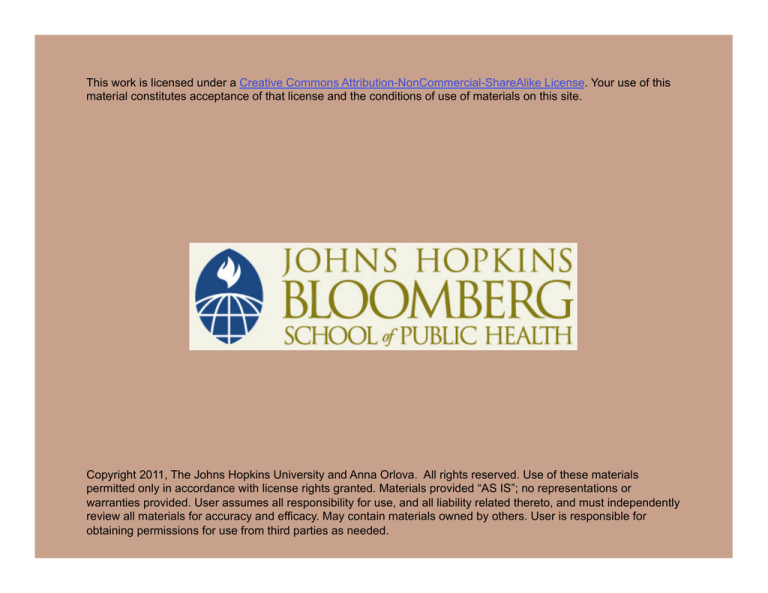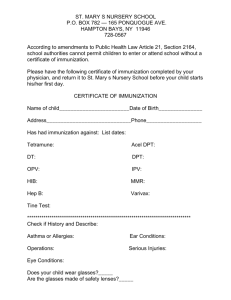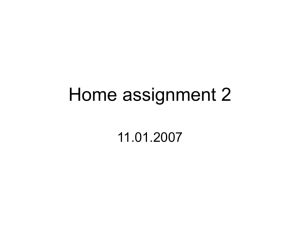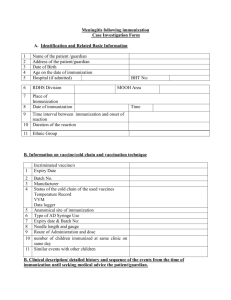
This work is licensed under a Creative Commons Attribution-NonCommercial-ShareAlike License. Your use of this
material constitutes acceptance of that license and the conditions of use of materials on this site.
Copyright 2011, The Johns Hopkins University and Anna Orlova. All rights reserved. Use of these materials
permitted only in accordance with license rights granted. Materials provided “AS IS”; no representations or
warranties provided. User assumes all responsibility for use, and all liability related thereto, and must independently
review all materials for accuracy and efficacy. May contain materials owned by others. User is responsible for
obtaining permissions for use from third parties as needed.
Section C
Requirements Elicitation
Requirements Elicitation Includes:
Specifying goals
Specifying high-level system
architecture
Specifying actors (business and
technical)
Specifying hardware and
software requirements
Specifying functional and nonfunctional requirements
Specifying system evaluation
plan
Specifying project timeline and
documentation
Specifying use cases
Developing models/diagrams
- Use case, workflow, and
dataflow
3
Specifying Actors
Actors represent the external entities that interact with the system
Business actors: stakeholders and entities
- For example, providers, patients, public health practitioners,
public health agencies, hospitals, etc.
Technical actors: information systems
- For example, EHR-S, PHR, LIMS, etc.
4
Example of Immunization Registries: Goals and Actors
The goal of the immunization
registry is to help prevent
spread of infectious diseases
by timely administering
vaccination to children within
a geographic area
Business actors
- Patient
- Physician
- Nurse
- Immunization registry staff
Technical actors
- Provider EHR system
- Immunization registry
5
Requirements Elicitation Includes:
Specifying goals
Specifying high-level system
architecture
Specifying actors (business and
technical)
Specifying hardware and
software requirements
Specifying functional and nonfunctional requirements
Specifying system evaluation
plan
Specifying project timeline and
documentation
Specifying use cases
Developing models/diagrams
- Use case, workflow, and
dataflow
6
Specifying Functions
Function is the description of the interaction between the
information system and its environment
The environment includes the users (business actor) and external
systems (technical actor) with which the system interact
7
Specifying Functions
Generic functions of an information system include:
- Collect data (input)
- Manage data (verify, store, upload, etc.)
- Integrate data
- Analyze data (SAS, SPSS, STRATA, GIS)
- Generate reports (output, e.g., summary, reminders,
notification, alert, update, etc.)
8
Example: Immunization Registries
The goal of the immunization registry is to help prevent spread of
infectious diseases by timely administering vaccination to children
within a geographic area
To achieve this goal, the immunization registry system will support
the following functions:
- Consolidate (collect, manage, integrate) vaccination records
from multiple health care providers within jurisdiction,
- Generate reminder and recall notifications (analyze data and
generate reports) to providers and patients,
-
Assess clinic performance (analyze data and generate reports)
in vaccination coverage
9
Specifying Functions
A nonfunctional requirement is a constraint on the operation of
the system that is not related directly to a function of the system
Non-functional requirements have as much impact on the system as
functional requirements
10
Requirements Elicitation Includes:
Specifying goals
Specifying high-level system
architecture
Specifying actors (business and
technical)
Specifying hardware and
software requirements
Specifying functional and nonfunctional requirements
Specifying system evaluation
plan
Specifying project timeline and
documentation
Specifying use cases
Developing models/diagrams
- Use case, workflow, and
dataflow
11
Specifying Functions
Nonfunctional requirements falls into two categories:
1. Quality requirements
2. Constraints or pseudo requirements
12
Quality Requirements
Usability
Reliability, dependability, robustness, safety
Performance (response time, throughput, availability, accuracy)
Supportability, adaptability, maintainability, portability
Implementation
13
Constraints or Pseudo Requirements
Implementation requirements
Interface requirements
Operation requirements
System security requirements
Packaging requirements
Legal requirements
14
Requirements Elicitation Includes:
Specifying goals
Specifying high-level system
architecture
Specifying actors (business and
technical)
Specifying hardware and
software requirements
Specifying functional and nonfunctional requirements
Specifying system evaluation
plan
Specifying project timeline and
documentation
Specifying use cases
Developing models/diagrams
- Use case, workflow, and
dataflow
15
Specifying Use Cases
Use cases are general sequences of events that describe all the
possible actions between an actor and the system for a given piece
of functionality
16
Example: Immunization Registry
Use case name
Immunization
Actors
Patient, physician, nurse, immunization registry (IR) staff,
EHR system, immunization registry
Flow of events
1. Patient comes to physician for a general check-up, and
he/she is due for immunization
2. Physician orders an immunization
3. Nurse administers an immunization
4. Nurse enters data on the immunization in the
Electronic Health Record (EHR) system
5. Nurse electronically sends immunization data to the
local immunization registry
6. Immunization registry staff receives data
Entry conditions EHR system
Exit conditions
Immunization registry
Quality
Daily updates
17
Use Case and Actors
Identification of actors and use cases within an application domain
results in the definition of the boundary of the system
- That is, in differentiating the tasks accomplished by the system
The actors are outside the boundary of the system, whereas the use
cases are inside the boundary of the system
18
Requirements Elicitation Includes:
Specifying goals
Specifying high-level system
architecture
Specifying actors (business and
technical)
Specifying hardware and
software requirements
Specifying functional and nonfunctional requirements
Specifying system evaluation
plan
Specifying project timeline and
documentation
Specifying use cases
Developing models/diagrams
- Use case, workflow, and
dataflow
19
Modeling
Modeling is one of the basic methods of science
A model is an abstract representation of a domain (a field, a
problem) that enables us to answer questions about the domain
Models allow to visualize the domain
20
Modeling
Software engineering is a field that deals with building software
products; it includes:
- A modeling activity to understand an organization of the
application domain
- A problem–solving activity to search for acceptable solution.
- A knowledge-acquisition activity that collects data, organize it
into information and formalize it into knowledge.
- A rationale-driven activity that puts the found solution in the
context in which it will be used in a decision-making process
and rationale behind these decisions
21
Modeling
To communicate your needs to developers, you need to learn
developer’s language
This language is modeling
22
Foundation of Successful IT Application: Modeling
Developers
You—user
Information
Technology
Informatics
Adapted by CTLT from CP Friedman. (1995). Where's the science in medical informatics? J Am Med Inform Assoc, 65–67.
23
Modeling in Software Engineering
Software engineering uses modeling of the domain to:
- Capture domain knowledge
- Precisely specify requirements
That is, describe a solution in a format of a structured
document (specification) so that all stakeholders (actorsusers) may understand and agree on them
- Guide the thought process
- Generate potential configuration of the system describing its
generic structure and meaning
- Abstract specifications of the essential structure of the system
-
Tell what something does (functional specification) as well as
how the function is accomplished (implementation)
Source: Rumbaugh et al. (1999). Unified Modeling Language Manual.
24
Developer’s Language: Graphical Symbols
Unified modeling language (UML) is a standard used by developers to
model the application domain
UML is a language of graphical symbols that are used in depicting
and describing:
a. A system in general system architecture
b. System components
c. The interaction of the system components
Developer’s language is the notation for representing objectoriented models
Source: Rumbaugh et al. (1999). The Unified Modeling Language Manual, 23–29; http://www.uml.org
25
Developer’s Language: Notation
A notation is a graphical or textual set of rules for representing a
model
- E.g., the Roman alphabet is a notation for representing words
To enable accurate communication a notation must:
- Come with a well-defined semantics
- Be well suited for representing a given aspect of a system
- Be well understood among project participants
In the latter lies the strength of standards and conventions: when a
notation used by a large number of participants, there is little room
for misinterpretation and ambiguity
26
The Goal of UML
The goal of UML is to:
- Provide a standard notation that can be used by all objectoriented methods
- Select and integrate the best elements of precursor notations
Source: http://www.uml.org
27
UML Models
The functional model, represented in UML with use case diagrams,
describes the functionality of the system from the user’s point of
view
The object model, represented in UML with class diagram,
describes the structure of the system in terms of objects,
attributes, associations, and operations
- E.g., HL7 RIM
The dynamic model, represented in UML with interaction diagrams,
statecharts diagram, and activity diagrams, describes the internal
behavior of the system
- Interaction diagrams describe behavior as a sequence of
messages exchanged among a set of objects
- Statechart diagrams describe behavior in terms of states of an
individual object
Source: http://www.uml.org
28
Five UML Notations
1. Use case diagrams
2. Class diagrams
3. Interaction diagrams
4. Statechart diagrams
5. Activity diagrams
Source: http://www.uml.org
29
Five UML Notations
1. Use case diagrams
2. Class diagrams
3. Interaction diagrams
We will focus only on
use case diagrams and
activity diagrams
4. Statechart diagrams
5. Activity diagrams
Source: http://www.uml.org
30
Use Case Diagrams
Use case diagram describes the use case in a graphical way
- That is, what a system does from the standpoint of an external
observer (actor)
- The emphasis is on what a system (functions) does rather than
how
31
Use Case Diagram Symbols
Rectangular box: represents the Application
Domain described in the Use Case
- For example, immunization
Actor: any entity (object) that interacts with
the system (e.g., end user, another system,
etc.)
Oval: depicts the function to be provided by the
system that yields a visible result for an actor
Line: indicates action
- Connects the actor to the function in which
he participates in the system
- Highlights the relationship between objects
in the system
Functions
32
Use Case Diagram Symbols
Public Health Domain
Action
Use cases
Actor
33
Specifying Use Case—Use Case Format: Immunization
Use case name
Immunization
Actors
Patient, physician, nurse, immunization registry (IR) staff,
EHR system, immunization registry
Flow of events
1. Patient comes to physician for a general check-up, and
he/she is due for immunization
2. Physician orders an immunization
3. Nurse administers an immunization
4. Nurse enters data on the immunization in the
Electronic Health Record (EHR) system
5. Nurse electronically sends immunization data to the
local immunization registry
6. Immunization registry staff receives data
Entry conditions EHR system
Exit conditions
Immunization registry
Quality
Daily updates
34
UML Use Case Diagram: Immunization
Immunization domain
1. Visits
provider
2. Orders
immunization
Patient
Provider
3. Administers
immunization
4. Enter
Immunization
data in EHR
Nurse
5. Send data
to registry
6. Receives data
Source: http://www.uml.org
Immunization
registry staff
35
Work Flow and Data Flow Diagrams
Work flow diagrams: notation for representing user participation in
the system
Data flow diagrams: notation for representing systems in term of
data sources and data transformation
36
Work Flow and Data Flow Diagram Symbols
Rectangular box: represents Business Actor =
entity (object) involved in the system
- For example, patient, provider, public
health agency, etc.
Diamond: represents a decision point in the
process
- Typically, it requires a Yes/No response
that triggers further activities within the
system—for example, provider orders
immunization
Rounded box: represents the event that
happens automatically
- For example, nurse administers
immunization as ordered by provider
37
Work Flow and Data Flow Diagram Symbols
Line with arrow: shows the order/direction of
steps/activities (flow of steps) within the
system
Paper sheet or e-encounter record symbol:
represents data recording points within the
system
Technical Actor = information system
- EHR, IR, etc.
38
Work Flow and Data Flow
Immunization Electronic Data Submission
Patient
Patient
Physician
Visits
Physician
Nurse
Orders
immunization
Encounter
record
Vaccine
admin.
record
Receives
immunization
Nurse
Order
record
EHR
Administers
immunization
Submits data to IR
EPR: electronic patient record
IR: immunization registry
Public health
agency
IR
39
Other Use Cases
There may be situations when an immunization will not be
administered at the time of the patient visit when immunization
might otherwise be due—for example:
- Provider does not have the immunization history of the patient
to know if immunization is due
- Patient is due for immunization but has contraindications—for
example, a fever—so immunization has to be postponed
- Patient is due for immunization but refuses to be immunized
because of beliefs
- Etc.
These various scenarios described as Use Cases are the lower levels
of knowledge representation of the immunization domain
40
Requirements Elicitation Includes:
Specifying goals
Specifying high-level system
architecture
Specifying actors (business and
technical)
Specifying hardware and
software requirements
Specifying functional and nonfunctional requirements
Specifying system evaluation
plan
Specifying project timeline and
documentation
Specifying use cases
Developing models/diagrams
- Use case, workflow, and
dataflow
41



